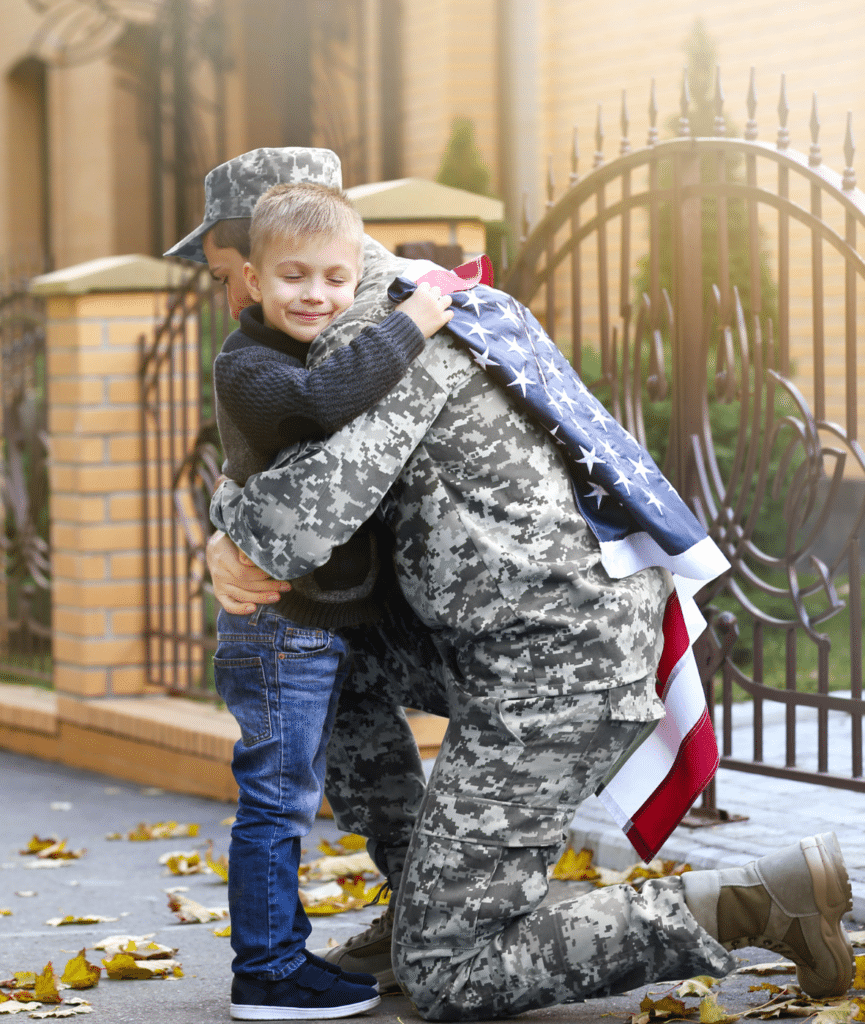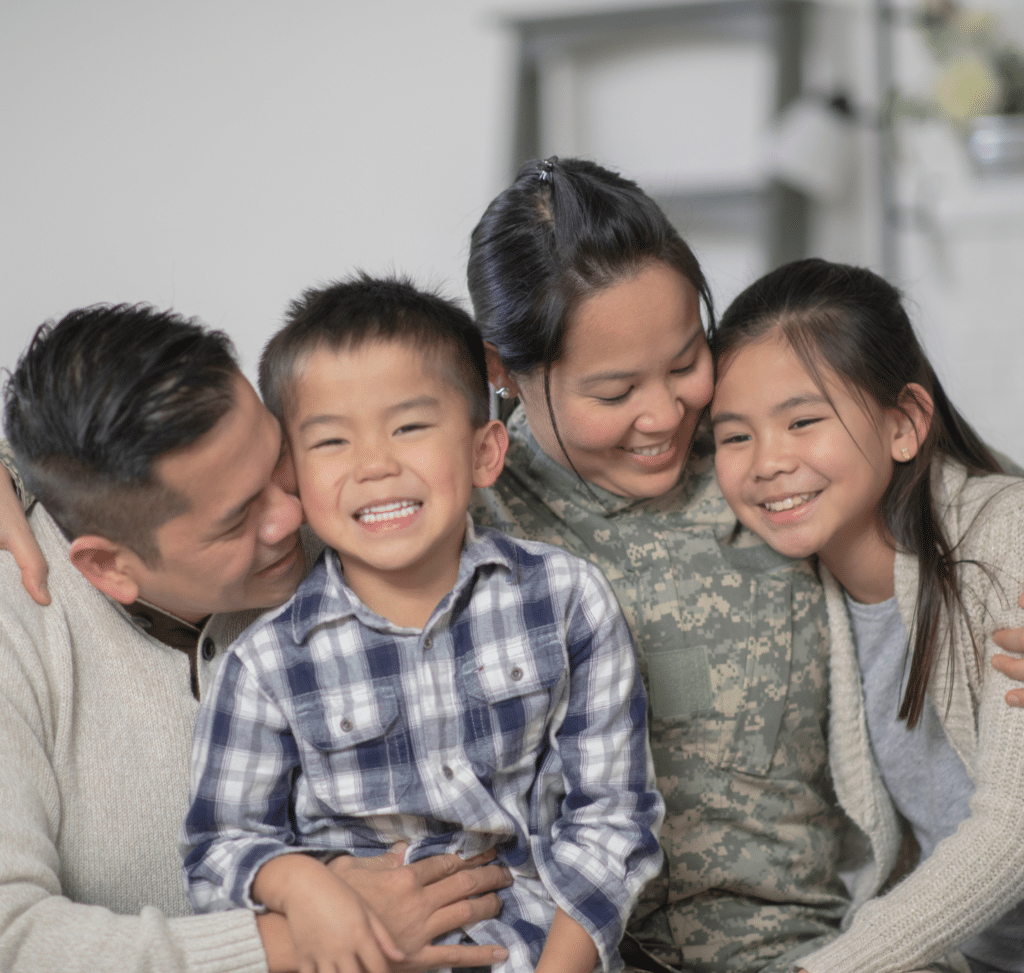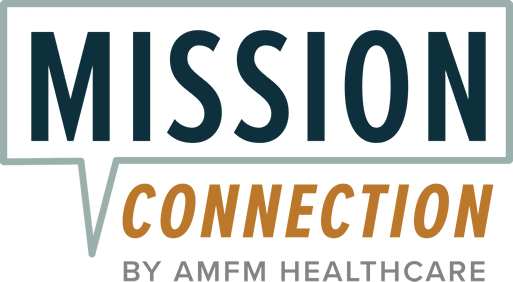How to Support a Veteran Struggling with Mental Health

It may be surprising – or perhaps not – to find out that up to 40% of veterans returning home from service are in need of mental health care.¹ Yet, sadly, not all veterans who need the help actually seek it. This is often due to stigma, a sense of pride, or the feeling that asking for help means admitting defeat. Sometimes, it’s even hard to name what’s going on under the surface.
Research shows that PTSD is one of the mental health conditions most frequently diagnosed in veterans.² Nightmares, hypervigilance, and social withdrawal can all be quiet signals that something like PTSD is going on.³ However, anxiety, trauma, depression, and moral injury could also be at play.
When signs of a mental health condition are brushed off or hidden, it gets harder to heal. Providing emotional support for veterans can be challenging, but the rewards are a loved one who feels capable of returning to civilian life with hope and motivation.
If someone you care about has served in the military and is showing signs of mental health issues – or just doesn’t seem like themselves lately – your support can make a big difference. This guide can help, as it walks you through the following ways to support a veteran with PTSD:
- Understanding the mental health needs of veterans
- Recognizing how to help veterans with depression and anxiety
- Coping strategies for veterans’ families
- Support groups and resources for military families
- How Mission Connection can help veterans in need

Understanding Veterans’ Mental Health Needs
Many veterans return home with a physical injury or scars that are impossible not to notice. Yet others carry pain that’s harder to recognize. The return to civilian life can stir up unexpected emotions and strain even the closest relationships. However, before you can recognize how to start helping, it’s good to understand the basics of veterans’ mental health needs.
The most common veteran mental health challenges include:
- Post-traumatic stress disorder (PTSD)
- Insomnia ⁴
- Depression
- Mood swings
- Generalized anxiety disorder
- Moral injury ⁵
- Traumatic brain injury (TBI)
- Military sexual trauma (MST)
- Suicidal thoughts or behavior
- Adjustment disorders ⁶
At first, veterans may not see their symptoms as mental health conditions and consider them a normal part of returning to civilian life. That is, until the symptoms start negatively impacting daily life and general life satisfaction. It’s usually at this point that veterans and families seek out organizations known for helping veterans with mental health issues.
With a deeper understanding of these mental health conditions, family support for veterans can provide the safety and stability that a veteran needs. For this reason, the following information covers how to help a veteran with the most common mental health conditions after service: depression, anxiety, and PTSD.
How to Help a Veteran With Depression
Helping veterans with mental health issues may include trying to uncover the root of depression and guiding your loved one back to “normal” life. What’s interesting is that depression doesn’t always show up as sadness, especially in veterans.
For instance, lesser-known signs of depression include:
- Withdrawing from people
- Lack of motivation
- Loss of interest in activities
- Increased irritability or anger
- Physical aches or pains with no clear cause⁷
- Trouble concentrating or making decisions
- Feeling numb or emotionally flat
- Sleeping too much or too little
- Loss of interest in sex or intimacy
- Coping in unhealthy ways, such as risky behaviors
- Feeling like a burden to others
If you’re wondering how to help a veteran with depression, it’s important to know that there’s no single fix that works for everyone. But there are simple, evidence-based ways to support veteran recovery. A combination of lifestyle changes and professional help often brings the best results. Some of the most effective tools include:
- Building a daily routine that offers structure
- Getting regular exercise, even short walks
- Eating balanced meals that support energy and focus
- Spending time outside or in natural light
- Reconnecting with hobbies or creative outlets
- Prioritizing rest and improving sleep habits
- Joining a peer support group
- Seeking professional guidance
Family support for veterans can go a long way, but sometimes it’s not enough. Professional care isn’t a last resort, but one of the strongest supports available. Peer groups and therapy give veterans a space to talk openly, gain tools, and feel less alone in what they’re facing. In some instances, veterans may be prescribed antidepressants to help them navigate through the emotional rough patches of reintegration into civilian life.
Supporting Veterans With Anxiety
Three out of ten veterans report experiencing anxiety symptoms.⁸ Anxiety can show up in ways that aren’t always obvious. For many veterans, it’s not about visible panic but rather a constant hum of tension in the background. When anxious, the body can stay braced, as if danger is still around the corner. This kind of internal alertness often makes it hard to fully relax.
Some signs of anxiety in veterans include:
- Hyperawareness of surroundings
- Seeming jumpy and easily startled
- Struggling with sleep due to restlessness or intrusive thoughts
- Difficulty concentrating or staying in conversations
- Muscle tension, jaw clenching, or headaches
- Irritability
- Avoiding loud or busy places like crowds or social gatherings
- Feeling emotionally distant or disconnected
- Anticipating something bad happening
Some things that can help veterans manage anxiety include:
- Following a daily rhythm that adds structure and reduces decision fatigue
- Using calming tools like breathwork, meditation, or body-based practices
- Cutting back on stimulants, especially caffeine, which can quietly ramp things up
- Moving the body regularly, even just a short walk or gentle stretching
- Creating space to rest without pressure to talk or perform
- Connecting with therapists who understand trauma and military experience
- Trying proven treatments, like CBT, EMDR, or medication when it fits ⁹
- Joining veteran-focused support spaces, where they don’t have to explain everything
Anxiety eases when the body stops scanning for danger. Supporting veterans with anxiety via these practices can help remind the nervous system that it’s okay to slow down and that it’s safe to relax.
Helping Veterans with Post-Traumatic Stress Disorder
PTSD has a way of impacting every facet of life if left unattended. As a loved one, understanding the signs of someone feeling stuck in trauma is the first step to supporting a veteran with PTSD.
Signs of PTSD in veterans might include:
- Flashbacks or vivid memories that seem to come out of nowhere¹⁰
- Difficulty falling or staying asleep
- Irritability or sudden shifts in mood
- Avoiding reminders of service or trauma
- Feeling detached, even in familiar settings
PTSD in veterans can stem from a range of experiences, yet combat exposure is one of the most common.¹¹ For instance, some veterans carry survivor’s guilt after living through events where others didn’t. Many also develop symptoms after medical trauma, serious injury, or experiencing military sexual trauma. Even extended exposure to high-stress environments can condition the body to remain on alert.
There’s also the reality of moral injury for many veterans. This is when someone sees or does something in service that doesn’t align with their personal values. This internal rupture can lead to shame, withdrawal, or the feeling that something inside is permanently altered.
Healing from PTSD often involves trauma-specific care. For example, some veterans respond well to trauma-focused care like EMDR or cognitive processing therapy. Additionally, many veterans find that they feel more comfortable starting in peer groups, where talking to people with shared experiences feels more natural.
When PTSD symptoms are intense, certain medications can take the edge off just enough to make healing work feel possible. There isn’t one “right” path, but with steady, layered support, many veterans begin to feel more grounded and connected again.
Coping Strategies for Veterans’ Families
Sometimes the importance of mental health support for veterans’ families is overlooked. Yet, living with someone who’s been through military service can bring unique stressors. Sometimes the mood shifts are extreme or sudden, and sometimes they’re unnervingly silent. And, as a family member, it’s easy to feel like you’re walking on eggshells or unsure how to help.
There’s no one-size-fits-all guide to helping a veteran with PTSD, anxiety, or depression. But there are a few things that can make supporting a veteran with PTSD or a similar condition more effective, including the following:
- Understand what your loved one is going through: Reading up on PTSD, depression, or anxiety can shift the way you interpret certain behaviors. For instance, what looks like distance might be emotional overload.
- Take care of yourself: Whether it’s stepping outside for ten quiet minutes or going to your own therapy, your stability matters too.
- Keep some things predictable: Having a few consistent touchpoints, like sharing morning coffee or walking the dog together, can give the day a rhythm when everything else feels uncertain.
- Reach out when needed: You don’t have to do this alone. Support groups and therapists can help you process what’s happening without carrying it all on your own.
- Be a steady presence: You don’t need to solve your loved one’s pain. Just staying close, without pushing, can be enough to help them start to feel safe again. Even when things feel complicated, simple acts of care done consistently can offer a sense of safety that words sometimes can’t
Military Family Support Groups
Most people often don’t really get what it’s like to be in a military family. You may end up carrying a lot of worry, adjustment, and silence – and these issues aren’t always easy to talk about. This is why military family support groups exist. They’re spaces where spouses, parents, or even kids of veterans can talk with people who’ve lived through similar experiences.
VA support for veterans’ families has been ramped up over the years. The Department of Veterans Affairs (VA) has shown dedication to providing mental health support for veterans’ families by offering several programs for families supporting a veteran with PTSD. But it’s not just about formal help – sometimes it’s just good to sit in a room (or join an online forum) with others who understand the background noise you live with. We discuss some resources for families of veterans next.
Resources for Families of Veterans
Trying to help someone you love while also managing your own stress isn’t easy. And for many families, it’s hard to even know where to begin. But there are resources for families of veterans available from the VA and nonprofits that make the weight easier to carry.
A few places to start include:
- VA Caregiver Support: Offering help for family members caring for a veteran day-to-day
- Military OneSource: A 24/7 resource for advice, info, and mental health referrals
- NAMI Homefront: Free education on how to support a loved one with mental health struggles
- Give an Hour: Connecting veterans and families with therapists who offer their time for free
- Blue Star Families: Focusing on building community and support networks so families feel less alone
Reach Out to Mission Connection for Guidance on Navigating Veteran Mental Health Issues
Finding the right kind of mental health support for a veteran or yourself can feel daunting. At Mission Connection, we help take some of that weight off.
We offer support that works for real life and can direct you to various mental health resources for military families. Whether you’re dealing with a mental health issue, looking for family therapy for veterans’ mental health, or just trying to adjust to the pace of civilian life, our team works with you to figure out what kind of care fits. And this support also extends to the families of veterans.
Contact our team to get answers, talk through the next steps, or explore programs that actually meet your needs when supporting a veteran with PTSD.

References
- Taylor, S., Miller, B. L., Tallapragada, M., & Vogel, M. (2020). Veterans’ transition out of the military and knowledge of mental health disorders. Journal of Veterans Studies, 6(1), 85. https://journal-veterans-studies.org/articles/10.21061/jvs.v6i1.131
- Tedla, A., Asnakew, S., Legas, G., Munie, B. M., Tareke, M., & Beka, M. (2024). Post-traumatic stress disorder among military personnel admitted at the Northwest Command Level Three Military Hospital, Bahir Dar, Ethiopia, 2022: An institution-based cross-sectional study. Frontiers in Psychiatry, 15, 1410630. https://www.frontiersin.org/journals/psychiatry/articles/10.3389/fpsyt.2024.1410630/full
- Messman, B. A., Fentem, A., Compton, S. E., Griffith, E. L., Blumenthal, H., Contractor, A. A., & Slavish, D. C. (2023). The role of affect in associations between sleep disturbances and posttraumatic stress disorder symptoms: A systematic review. Sleep Medicine, 110, 287–296. https://www.sciencedirect.com/science/article/abs/pii/S1389945723003155
- Molloy, N., & Murphy, D. (2023). Associations between sleep difficulties and health outcomes in treatment-seeking veterans. Occupational Medicine (Oxford, England), 73(7), 439–445. https://pmc.ncbi.nlm.nih.gov/articles/PMC10588775/
- Nichter, B., Norman, S. B., Maguen, S., & Pietrzak, R. H. (2021). Moral injury and suicidal behavior among U.S. combat veterans: Results from the 2019–2020 National Health and Resilience in Veterans Study. Depression and Anxiety, 38(6), 606–614. https://pubmed.ncbi.nlm.nih.gov/33666315/
- Morgan, M. A., O’Gallagher, K., Kelber, M. S., Garvey Wilson, A. L., & Evatt, D. P. (2023). Diagnostic and functional outcomes of adjustment disorder in U.S. active duty service members. Journal of Affective Disorders, 323, 185–192. https://www.sciencedirect.com/science/article/abs/pii/S0165032722013398
- OUP. (n.d.). Pain Medicine. Retrieved June 5, 2025, from https://academic.oup.com/painmedicine/article/23/2/295/6395369
- Macdonald-Gagnon, G., Stefanovics, E. A., Potenza, M. N., & Pietrzak, R. H. (2024). Generalized anxiety and mild anxiety symptoms in U.S. military veterans: Prevalence, characteristics, and functioning. Journal of Psychiatric Research, 171, 263–270. https://pubmed.ncbi.nlm.nih.gov/38325107/
- Levin, A. (2007). Combat veterans with PTSD benefit from online CBT. Psychiatric News, 42(22), 19. https://psychiatryonline.org/doi/10.1176/pn.42.22.0019
- Chambliss, T., Hsu, J.-L., & Chen, M.-L. (2024). Post-traumatic stress disorder in veterans: A concept analysis. Behavioral Sciences, 14(6), 485. https://pmc.ncbi.nlm.nih.gov/articles/PMC11200391/#:~:text=Veterans%20with%20PTSD%20often%20have,intrusive%20memories%20of%20traumatic%20events
- Schnittker, J. (2018). Scars: The long-term effects of combat exposure on health. Socius: Sociological Research for a Dynamic World, 4, 237802311881301. https://journals.sagepub.com/doi/full/10.1177/2378023118813017
